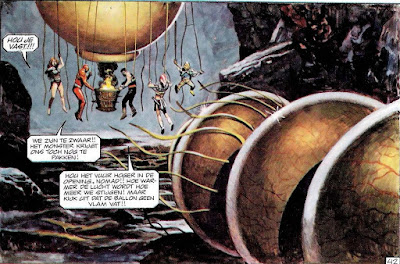The difficulty with dealing with the fantastic is too-often repeated tropes/ideas become cliches, and kind of unfantastic. The D&D (read: prevailing) view of elves, dwarves, dragons, etc. has thoroughly mundanified and Gygaxian-realismed these things into yawns for a lot of people. Now, it's resonable to ask just how fantastic an element needs to be in a game about killing stuff and taking its treasure, but feeling burned out on the standard tropes has led to a lot of folks reaching for the Weird. It's funny that almost 100 year-old tropes can seem fresh and untrod territory, but fantasy is nothing if not a conservative genre, I guess.
The trouble is, those elements might get a little stale for some people, too, with repetition. So there's the New Weird or gonzo, of course, but I'd also like to suggest that maybe things don't have to be wholly "new." They just have to be a
bit surprising, and those surprises can each be employed a small number of times so they stay fresh.
I think looking back to mythology and folklore helps a lot, because there are a lot of forgotten elements in those that make no sense from the modern perspective, and so have tended to be dropped from retellings. Medieval bestiaries are good, too.
Here's an interesting thing I came across a couple of years ago: "mundane" animals as treasure guardians:
Washington Irving notes the folk-belief that the spiritual guardians of buried treasure could take on the form of animals, such as toads. “Wild vines entangled the trees, and flaunted in their faces; brambles and briers caught their clothes as they passes; the garter snake glided across their path; the spotted toad hopped and waddled before them; and the restless cat-bird mewed at them from every thicket. Had Wolfert Webber [a man in search of treasure, but who was unschooled in folk-magic] been deeply read in romantic legend, he might have fancied himself entering upon forbidden enchanted ground; or that these were some of the guardians set to keep watch upon buried treasure.” Diedrich Knickerbocker (pseud.), “The Adventures of the Black Fisherman,” Tales of a Traveller (1825), 2: 356.
So replace a dragon or some other "fantastic" creature with just an animal, acting kind of strange and maybe able to talk.
Adventure Time! sort of (I'm sure unknowingly) uses this trope with a frog that serves as a portal to lumpy space:
Monsters that want to chat, instead of kill the party immediately, are also a mythological staple that is not as often done in rpgs (though I try to do a bit of this in
Mortzengersturm). This one can hard because PCs are a stabby lot, but it can help put them in the old school mindset of the goal being to get treasure, not necessarily kill things. A loquacious monster is a challenge, not an encounter.
Finally I would suggest the behavioral reskin (this is sort of a broader application of the talking monster principle). We're all familiar with putting new flesh on a set of stats, but a more subtler reskin will sometimes surprise players more. If goblins aren't following their Gygaxian role, but instead all consumed with building/repairing some ancient machine, maybe
that hooks the PCs interest? Maybe it's only me, but I think
backwards talking derro that can only be understood if you look in a mirror as they speak, move a known monster away from an evil dwarf back to the Shaverian paranoid weirdness.
Those are just some examples, which may or may not work for you, but I'm sure you can think of your own. Instead of trying hard to make things fresh and new, just make them a little odd.
























